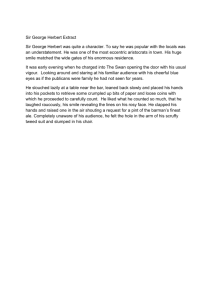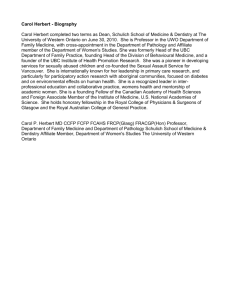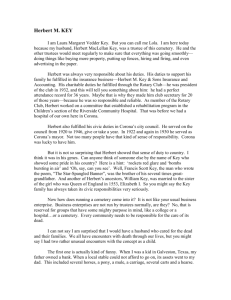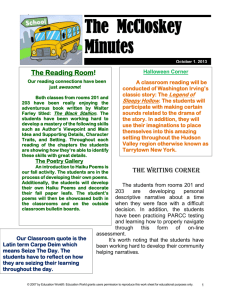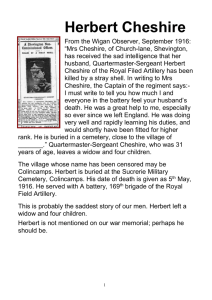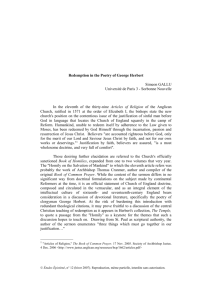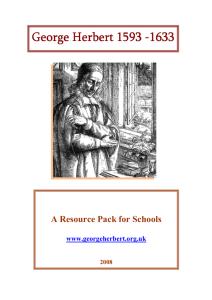Herbert The Temple An Introduction
advertisement
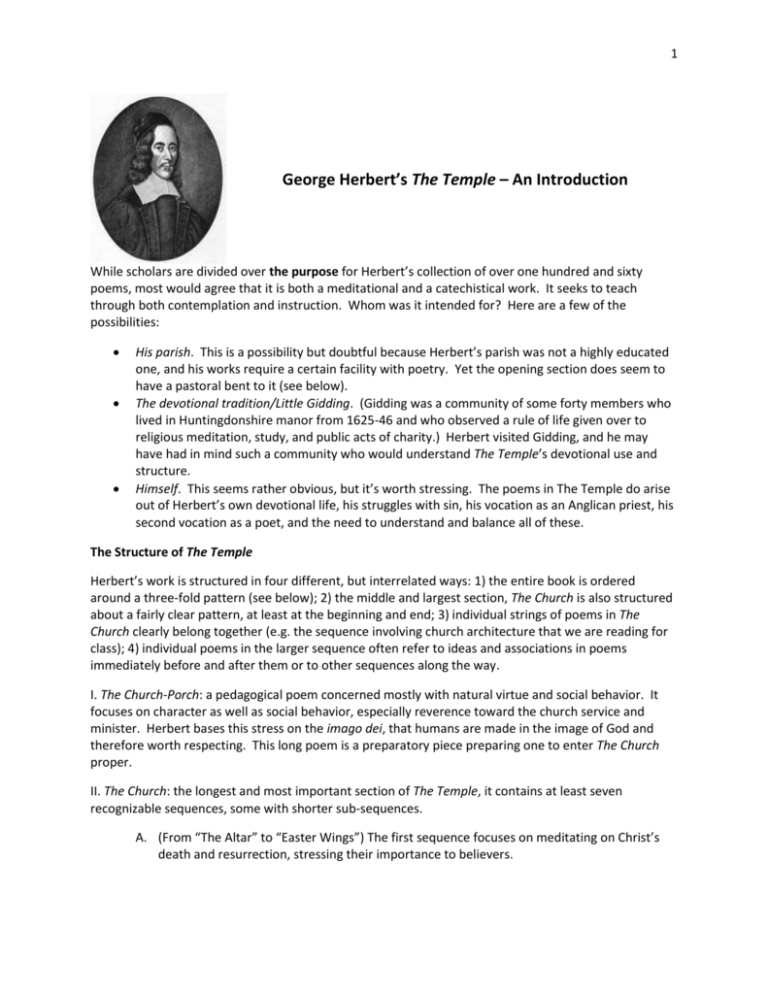
1 George Herbert’s The Temple – An Introduction While scholars are divided over the purpose for Herbert’s collection of over one hundred and sixty poems, most would agree that it is both a meditational and a catechistical work. It seeks to teach through both contemplation and instruction. Whom was it intended for? Here are a few of the possibilities: His parish. This is a possibility but doubtful because Herbert’s parish was not a highly educated one, and his works require a certain facility with poetry. Yet the opening section does seem to have a pastoral bent to it (see below). The devotional tradition/Little Gidding. (Gidding was a community of some forty members who lived in Huntingdonshire manor from 1625-46 and who observed a rule of life given over to religious meditation, study, and public acts of charity.) Herbert visited Gidding, and he may have had in mind such a community who would understand The Temple’s devotional use and structure. Himself. This seems rather obvious, but it’s worth stressing. The poems in The Temple do arise out of Herbert’s own devotional life, his struggles with sin, his vocation as an Anglican priest, his second vocation as a poet, and the need to understand and balance all of these. The Structure of The Temple Herbert’s work is structured in four different, but interrelated ways: 1) the entire book is ordered around a three-fold pattern (see below); 2) the middle and largest section, The Church is also structured about a fairly clear pattern, at least at the beginning and end; 3) individual strings of poems in The Church clearly belong together (e.g. the sequence involving church architecture that we are reading for class); 4) individual poems in the larger sequence often refer to ideas and associations in poems immediately before and after them or to other sequences along the way. I. The Church-Porch: a pedagogical poem concerned mostly with natural virtue and social behavior. It focuses on character as well as social behavior, especially reverence toward the church service and minister. Herbert bases this stress on the imago dei, that humans are made in the image of God and therefore worth respecting. This long poem is a preparatory piece preparing one to enter The Church proper. II. The Church: the longest and most important section of The Temple, it contains at least seven recognizable sequences, some with shorter sub-sequences. A. (From “The Altar” to “Easter Wings”) The first sequence focuses on meditating on Christ’s death and resurrection, stressing their importance to believers. 2 B. (From “Holy Baptism” to “Holy Communion”) The second sequence focuses on the sacraments and prayer as teaching us of our sin and our need for repentance and faith. C. (From “Antiphon (1) to “Antiphon (2)”) The third sequence looks at the role of liturgical worship – the church calendar, the church proper, and daily reflections within the cycle of worship. It can further be divided into five sequences, though some of these are more clear than others: 1. (From “Antiphon (1) to “Holy Scriptures (2)”) This subsection focuses on our love of God – how to best and most effectively praise him. Herbert keeps referring to the question of purifying and clarifying his poetry, wit, love, and worship. 2. (From “Whitsunday” to “Trinity Sunday”) This is one of the most obvious and least disputed sequences in The Temple. I focuses on elements of the church calendar, church worship, and of church architecture as a kind of sacred space where God works on our souls. It again stresses our need for Christ to restore us from our sin. 3. (From “Content” to “Denial”) The next three subsequences are not as clearly marked, so this represents only one way to divide them. This section focuses on the puzzle of our sin and our mind’s denial of the truth. It also praises Sunday as the best of days. 4. (From “Christmas” to “Lent”) This section tends to be more conceptual and sermonic. The poems tend to stress the importance of what we know and why that is limited in this life. 5. (From “Virtue” to Antiphon (2)”) This final subsection often returns to the theme of human beings as a microcosm. D. (From “Unkindness” to “The Pulley”) This is the longest sequence and, frankly, the least stable as a continuous pattern. This large section tends to revolve around the daily life of the Christian, in particular the struggle with carnality. It is hard to characterize beyond this. It has a large number of groupings of poems, several of which focus on mortification or sin’s costs. There are also a large number of poems that can be called “puzzle” poems or typographical experiments; these tend to play language games with certain letters, names, symbols, or biblical types in order to say/reveal something about Christ and /or his people. The sequence ends revolving about two reflections on Herbert’s priestly vocation, “The Collar” and “Joseph’s Coat.” E. (From “The Priesthood” to “Aaron”) This section focuses on priestly duties. It looks at the mature Christian’s call to surrendering to God and laying aside personal ambition. F. (From “The Odour” to “The Elixir”) This sixth sequence dwells on the sweetness and fellowship of being with God – his beauty, health, and value. True worship enjoins us not to go back to our worldly ways but to have a sense of dependence upon God. G. (From “A Wreath” to “Love (3)”) This final sequence is about last things – death, judgment day, heaven. It ends with Herbert accepted at the Marriage Feast of the Lamb. 3 III. The Church Militant: A lesson in church history – the nature of providence, human struggle, church corruption, and the ultimate triumph of the gospel. This poem reviews such subjects as Noah, Moses, Christ, the influx of Greco-Roman philosophy, and the Donation of Constantine. It inveighs against false gods such as food, poetry, emperors, and Islam. Herbert charges the hierarchy of the Roman Catholic Church with being a combination of all these idols because it became a secular power. Herbert looks forward to the gospel going with the oppressed to America, even as sin dogs its heels. In the end with the cross, the church will conquer sin. Thus Herbert’s collection moves from: A preparatory study of virtue and courtesy to The struggle of the self to no longer be divided but unified in Christ. This struggle is examined by moving from 1. 2. 3. 4. 5. 6. 7. A focus on Christ To the sacraments To liturgical worship To the daily struggle of the Christian To one’s priesthood and maturity To a focus on fellowship with God And to a sense of last things. Finally, Herbert ends with a lesson in church history and the triumph of the gospel.
